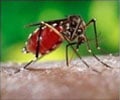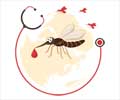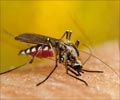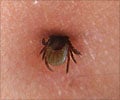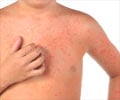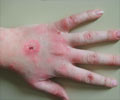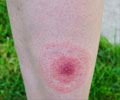Travel Med Infect Dis 2020 Jan 30
The safety and applicability of synthetic pyrethroid insecticides for aircraft disinsection: A systematic review.
Pang AM, Gay S, Yadav R, Dolea C, Ponce C, Velayudhan R, Grout A, Fehr J, Plenge-Boenig A, Schlagenhauf P
Air travel contributes to the global spread of vectors and vector-borne infections. Although WHO provides guidance on methods for disinsection of airc ...
Read More
Source: PubMed
Trends Parasitol. 2020 Jan 29
Skin Interface, a Key Player for Borrelia Multiplication and Persistence in Lyme Borreliosis.
Bernard Q, Grillon A, Lenormand C, Ehret-Sabatier L, Boulanger N
The skin plays a key role in vector-borne diseases because it is the site where the arthropod coinoculates pathogens and its saliva. Lyme borreliosis, ...
Read More
Source: PubMed
Clin. Infect. Dis. 2020 Feb 01
First report of Candidatus Mycoplasma haemohominis infection in Australia causing persistent fever in an animal carer.
Alcorn K, Gerrard J, Cochrane T, Graham R, Jennison A, Irwin PJ, Barbosa AD
Haemotropic mycoplasmas (haemoplasmas) infect animals and humans and can lead to clinical syndromes mainly characterised by haemolytic anaemia. A nove ...
Read More
Source: PubMed
Ticks Tick Borne Dis 2020 Jan 20
Transgenic functional complementation with a transmission -associated protein restores spirochete infectivity by tick bite.
Schwan TG, Raffel SJ, Battisti JM
The relapsing fever spirochete Borrelia hermsii and the Lyme disease spirochete Borrelia burgdorferi sensu stricto each produces an abundant, ortholog ...
Read More
Source: PubMed
Epidemics
Temperature-dependent variation in the extrinsic incubation period elevates the risk of vector-borne disease emergence.
Kamiya T, Greischar MA, Wadhawan K, Gilbert B, Paaijmans K, Mideo N
Identifying ecological drivers of disease transmission is central to understanding disease risks. For vector-borne diseases, temperature is a major de ...
Read More
Source: PubMed
Travel Med Infect Dis 2020 Jan 30
The safety and applicability of synthetic pyrethroid insecticides for aircraft disinsection: A systematic review.
Pang AM, Gay S, Yadav R, Dolea C, Ponce C, Velayudhan R, Grout A, Fehr J, Plenge-Boenig A, Schlagenhauf P
Air travel contributes to the global spread of vectors and vector-borne infections. Although WHO provides guidance on methods for disinsection of airc ...
Read More
Source: PubMed
Trends Parasitol. 2020 Jan 29
Skin Interface, a Key Player for Borrelia Multiplication and Persistence in Lyme Borreliosis.
Bernard Q, Grillon A, Lenormand C, Ehret-Sabatier L, Boulanger N
The skin plays a key role in vector-borne diseases because it is the site where the arthropod coinoculates pathogens and its saliva. Lyme borreliosis, ...
Read More
Source: PubMed
Clin. Infect. Dis. 2020 Feb 01
First report of Candidatus Mycoplasma haemohominis infection in Australia causing persistent fever in an animal carer.
Alcorn K, Gerrard J, Cochrane T, Graham R, Jennison A, Irwin PJ, Barbosa AD
Haemotropic mycoplasmas (haemoplasmas) infect animals and humans and can lead to clinical syndromes mainly characterised by haemolytic anaemia. A nove ...
Read More
Source: PubMed
Ticks Tick Borne Dis 2020 Jan 20
Transgenic functional complementation with a transmission -associated protein restores spirochete infectivity by tick bite.
Schwan TG, Raffel SJ, Battisti JM
The relapsing fever spirochete Borrelia hermsii and the Lyme disease spirochete Borrelia burgdorferi sensu stricto each produces an abundant, ortholog ...
Read More
Source: PubMed
Epidemics
Temperature-dependent variation in the extrinsic incubation period elevates the risk of vector-borne disease emergence.
Kamiya T, Greischar MA, Wadhawan K, Gilbert B, Paaijmans K, Mideo N
Identifying ecological drivers of disease transmission is central to understanding disease risks. For vector-borne diseases, temperature is a major de ...
Read More
Source: PubMed
Travel Med Infect Dis 2020 Jan 30
The safety and applicability of synthetic pyrethroid insecticides for aircraft disinsection: A systematic review.
Pang AM, Gay S, Yadav R, Dolea C, Ponce C, Velayudhan R, Grout A, Fehr J, Plenge-Boenig A, Schlagenhauf P
Air travel contributes to the global spread of vectors and vector-borne infections. Although WHO provides guidance on methods for disinsection of airc ...
Read More
Source: PubMed
Trends Parasitol. 2020 Jan 29
Skin Interface, a Key Player for Borrelia Multiplication and Persistence in Lyme Borreliosis.
Bernard Q, Grillon A, Lenormand C, Ehret-Sabatier L, Boulanger N
The skin plays a key role in vector-borne diseases because it is the site where the arthropod coinoculates pathogens and its saliva. Lyme borreliosis, ...
Read More
Source: PubMed
Clin. Infect. Dis. 2020 Feb 01
First report of Candidatus Mycoplasma haemohominis infection in Australia causing persistent fever in an animal carer.
Alcorn K, Gerrard J, Cochrane T, Graham R, Jennison A, Irwin PJ, Barbosa AD
Haemotropic mycoplasmas (haemoplasmas) infect animals and humans and can lead to clinical syndromes mainly characterised by haemolytic anaemia. A nove ...
Read More
Source: PubMed
Ticks Tick Borne Dis 2020 Jan 20
Transgenic functional complementation with a transmission -associated protein restores spirochete infectivity by tick bite.
Schwan TG, Raffel SJ, Battisti JM
The relapsing fever spirochete Borrelia hermsii and the Lyme disease spirochete Borrelia burgdorferi sensu stricto each produces an abundant, ortholog ...
Read More
Source: PubMed
Epidemics
Temperature-dependent variation in the extrinsic incubation period elevates the risk of vector-borne disease emergence.
Kamiya T, Greischar MA, Wadhawan K, Gilbert B, Paaijmans K, Mideo N
Identifying ecological drivers of disease transmission is central to understanding disease risks. For vector-borne diseases, temperature is a major de ...
Read More
Source: PubMed



